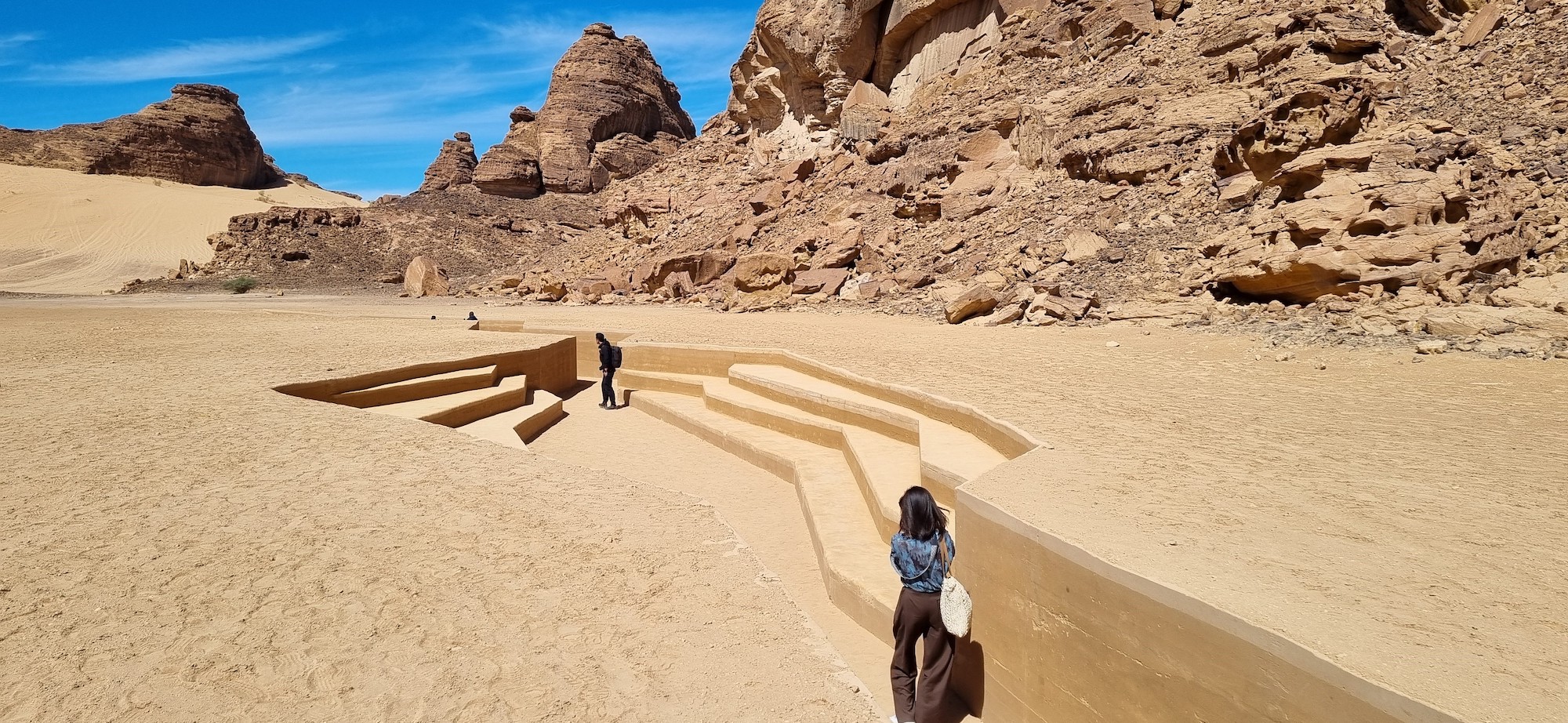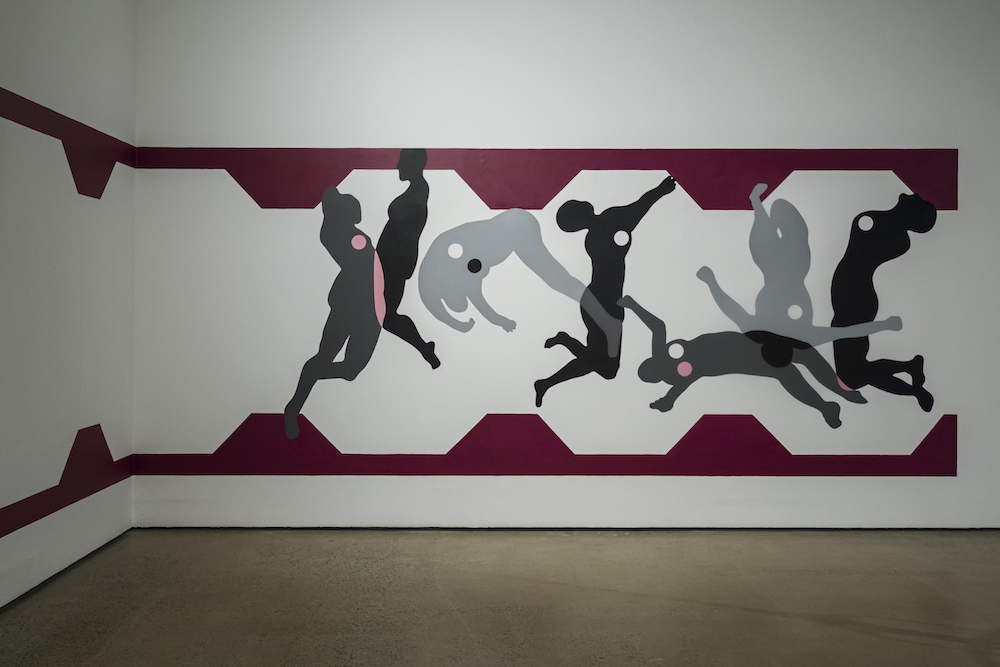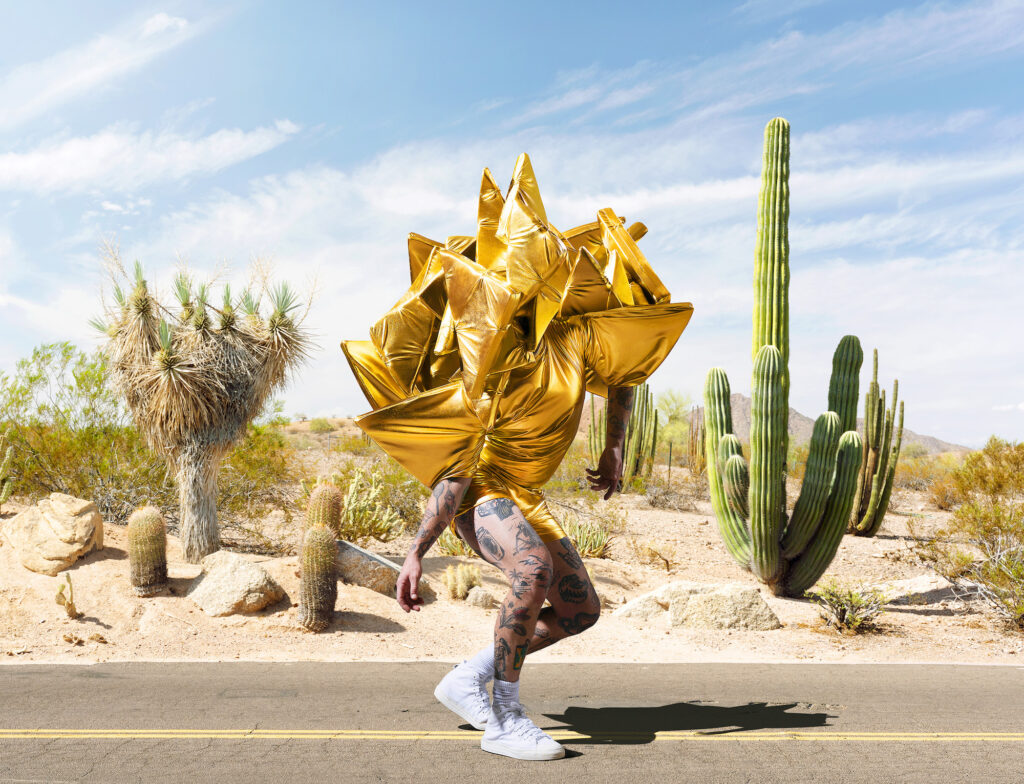
Jan Murphy Gallery has been transformed into a simulacrum of Southern Arizona; hot desert light emanates from the dazzling works that adorn the gallery walls. Gerwyn Davies has created a Mirage, a trick of the eye both within the gallery and his works. Twelve of his signature photographic works—featuring quirky costume creations—are augmented by five shimmering textile works. The photographs are surreal, unplaceable. They exist in a liminal zone between fantasy and reality, a curious combination of performance and portrait. Meanwhile, the textile banners indicate a new direction in Davies’ practice.
Davies’ photographs are at once recognisable and strange. Each hints at a familiar reality, yet his costumes render the landscapes fantastic. In Saguaro (2024), for example, a green sequined cactus-like form stands in a clearing, flanked by desert cacti. The lush reflective green of this costumed cactus contrasts with the dry green-grey of the desert. Incongruously, the cactus is holding a stubby of beer, its recognisable brand name just visible on the label. A similarly sparse work, Cola (2024), features a mirrorball-esque ensemble. Striking a contrapposto pose not dissimilar to the statue of David, yet instead of a rock Davies holds a sequined cup of cola. The bright Arizona sun bounces off his silver costume while stark white geometric buildings behind show palm tree shadows.
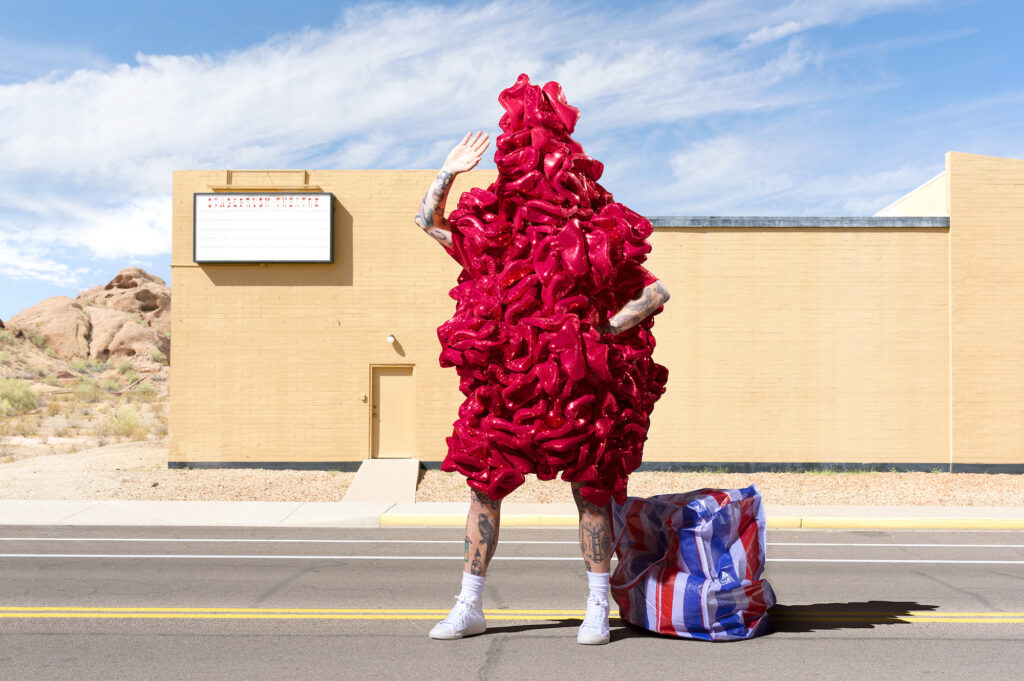
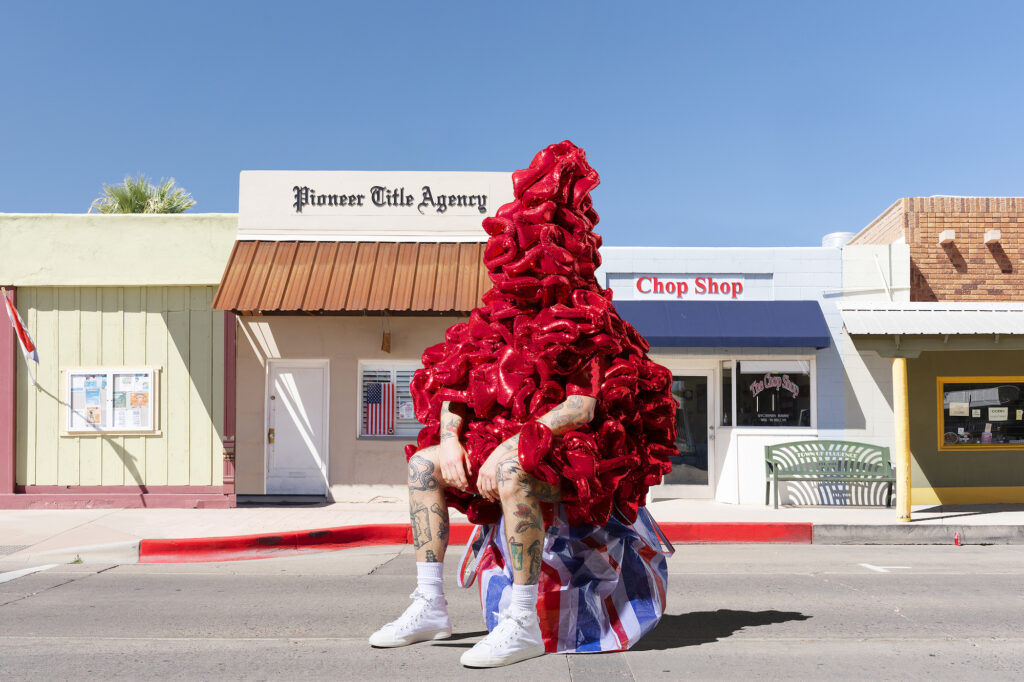
The only repeated costume in Mirage appears in the work Main Street (2024) and again in Troubadour (2024). In these works, a luscious red ensemble completely envelopes Davies from head to knee. This is in contrast to the other costumes in the exhibition, which stop at the upper torso. The red forms are vague, their glossy rich red colour suggestive of lips or even internal organs. In Troubadour, the figure gives a jaunty wave, his other hand placed on his hip in a power pose. He stands on the road, a storage bag by his side, in front of a nondescript theatre. Main Street reads like the second part of this character’s story, now sitting on the storage bag in a carpark, in front of a row of small-town shops. It is possible that these works comment on the realities of life as an artist or performer, making the journey from Australia to the United States seeking fame and fortune. The seated figure in Main Street, which lacks the physical dynamism of others, is the only figure that hints at the ordinary life existing underneath these costumed personas.
In each of Davies’ signature works, he is present yet deliberately obscured. His innocuous white sneakers and socks parade through each scene, casually flanking his tattooed legs. The eclectic imagery of Davies’ leg tattoos hint at the artist. His elaborate costumes and exaggerated poses further indicate a queer, flamboyant aesthetic. Yet Davies remains steadfastly hidden under his creations. While the artist is physically present in his photographs, he maintains a distance from the viewer.
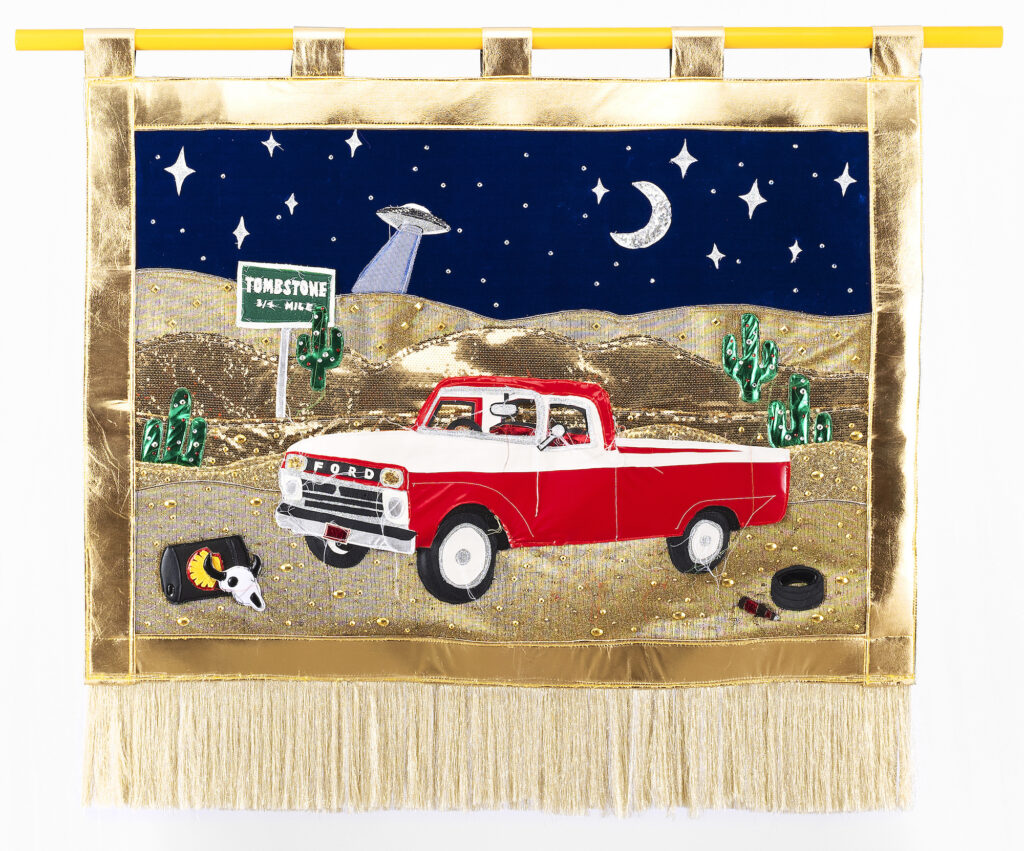
Accompanying the photographic works are five textile banners. While Davies’ is concealed by costumes and further distanced by the camera in his photographs, his textile banners bridge the gap between artist and viewer, bringing the rich material texture of his practice into the gallery. Constructed with elements from the artist’s costumes, they echo the humour of the photographs. Yet these are not merely rehashed versions of old costumes: they brim with detail and life, and encourage a reverence for the skilled and laborious construction that underpins Davies’ practice. A rattlesnake, cowboy boots, scorpion, and a Ford truck are all created from sequins, tulle, and pleather. Davies shows off his mastery of these difficult-to-manage glam fabrics, using them in unexpected ways. Through the tactile presence of these works, the viewer gains a sense of the artist’s presence, brought into the space through the fabrics that once adorned his body.
Each of Davies’ textile pieces are infused with recognisable signs, symbols, and motifs, transporting even those who have never visited Arizona into a quintessential America, full of big trucks, cacti, skulls, guns, and cheap motels. In Tombstone (2024), a red Ford pickup sits abandoned in the desert. In the night sky, above golden rolling hills, a UFO is visible in the distance. Davies lends his precise rendering of the fabric Ford truck an unsettling twist via the UFO and desert detritus. In No Vacancy (2024), a ubiquitous highway motel sign is transformed into a shimmering work of textile art, glittering as if our headlights have sought it out on the road. The use of glitzy textiles transforms these ordinary items and scenes into objects of beauty. By using select fabrics, Davies also imbues them with a queer sensibility. Sequins and pleather question the overt masculinity of the desert images and text.
In Gerwyn Davies’ Mirage, nothing is as it appears. His carefully conceived photographs tease us with their unplaceable charm and elusion of interpretation. In each, he is both hidden and distanced. In his textile works, Davies’ surreal costumes are reborn as lively, tactile banners. These bring Davies into the gallery, showcasing his impeccable sewing skills and in turn facilitating appreciation of the meticulous construction that underpins all of his works. Viewers know Davies for his ability to create fantastical costumes and scenes, and the new textile works bring a welcome addition to his practice, injecting a pop of texture into the gallery space.
Bree Di Mattina is a PhD candidate, art historian, and writer from Meanjin/Brisbane. Di Mattina’s research focuses on the history of textile and fibre art in Australia from 1970 to present. Her writing encompasses Australian art, feminist art, and craft.

